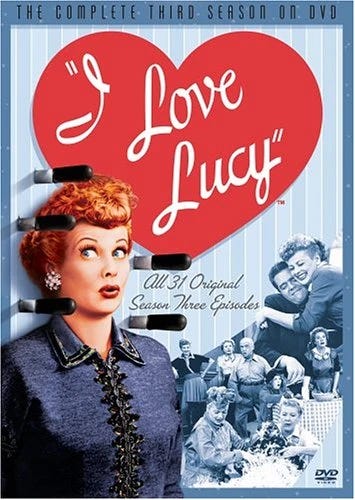Dear word explorer,
There was a strong response to last week’s Comfort Films post, with readers offering some of the movies they enjoy watching. Thanks for all your comments!
I didn’t touch upon TV series, because that is a category all of its own. Viewers are intrinsically more connected to TV characters who they have watched grow and evolve through numerous storylines over many years. Watching those shows were often family and friends events, where you’d gather (in person or virtually) to view the latest episode and dissect it afterwards. So the memory of watching the series may be tied to that warm sensation of sharing the experience with a mutual fan of the show. This is especially poignant if that special person has subsequently passed on, and you rewatch the show with their presence in mind.
This connection is true of movies too, but it is not the same level of commitment as to a long-running TV series, especially from an era when it was usual for TV scripted shows to have 22 episodes or more in a season.
If you want a handy graphic for how that trend has changed, here’s one from Parrot Analytics noting the significant shift from 2018.1
Rewatching movies or TV shows wasn’t even a conceivable pleasure prior to the affordable release of consumer VCRs, after the struggle between Betamax and Video Home System (VHS) formats in the late 1970s.2 A Betamax machine cost about $2,000 — $2,300 in 1975 (approx. $9,500+ today) and in 1977 VCRs retailed between $1,000 — $1,400 (approx. $4,400+ today). Those prices came down over the following decade, but this innovation was an expensive outlay in an era of economic uncertainty and when there weren’t many titles available to watch.
VHS won out by the early 1980s, but initially movie releases on VHS were expensive (each movie cost $79.99 and up) which kickstarted the VHS rental market. Blank tapes for recording weren’t terribly cheap either — they were initially priced about $20 a pop, and only dropped in price as the mass production of the machines and tapes geared up. Prices of tapes always varied based on the length of the recording time and the quality of the tape itself — quite important to serious fans since tape tears easily (and children seem to love unspooling cassettes) and repeat viewing degrades its quality.
While writing this I wondered what TV show kicked off the entire ‘box set’ phenomenon, and this led me down a number of rabbit holes.
There are two contenders, but the first one shouldn’t surprise you: Star Trek (the original series) and I Love Lucy. Both of them were released as TV series on VHS in 1985, but the entire first season of I Love Lucy dropped in one go, while Star Trek was released in batches of ten tapes at a time.
There’s a lot to appreciate here with these two mega franchises having the smarts to bet on a future technological trend, but they have a surprising connection.
Let’s consider first that the stars of I Love Lucy, Lucille Ball and husband Desi Arnaz, created their own production company in 1950, called Desilu productions, and produced the TV series themselves. It was merely the first of many innovations made by the couple.3 When I Love Lucy aired in 1951 it was the first thirty-minute scripted television program with an ensemble cast filmed on 35 mm film in front of a studio audience. Previously, it was though to be a waste of money to shoot on ‘movie-grade film’ and impossible to have a live audience on a sound stage. Karl Freund, the cameraman on I Love Lucy, and Arnaz developed the concept of a linked multifilm camera setup that shot the show using adjacent sets that were designed to accommodate a live audience and adhere to all the fire and safety codes. This is essentially the same setup used for sitcoms ever since.
The network executives balked at the cost of these innovations so Arnaz agreed for Desilu to cover the surplus, but in exchange the production company owned and controlled all rights to the film prints and negatives. As a result Desilu raked in the profits from reruns of the series. This was one of the savviest TV deals of all time.
I Love Lucy ran for six seasons with an average of 30 episodes per season. It was one of the most popular TV series at the time, and the episode ‘Lucy Goes to the Hospital’, aired in 1953, was watched by 71.7% of all households with television sets, which is about 44 million viewers at the time. It certainly cemented the love of the 30-minute sitcom format with audiences, and it’s a formula people still crave today.
In an example of the circular nature of technology, Pluto TV — a free ad-supported streaming television (FAST) service — launched a I Love Lucy channel in early 2023 which broadcasts the show continually.
So how does this link to Star Trek? Ball and Arnaz divorced in 1960, and by 1962 Ball bought out Arnaz’s holdings in Desilu. This meant that Ball was president and chief executive officer of Desilu, while starring in her own follow-on TV series. She was one of the most important women in American TV as a result. Under her stewardship Desilu developed other series such as Mission: Impossible (1966), Star Trek (1966) and Mannix (1967).
In 1967, Ball sold Desilu to Gulf+Western, which had also acquired Paramount Pictures, so the company was renamed Paramount Television. The era of media consolidation had begun in earnest. It’s rather head-wrecking to follow the subsequent mergers and sales between various entertainment corporations, but the current top player is Paramount Global, which owns all of the I Love Lucy catalogue, as well as the Star Trek series, and Pluto TV (which it bought back in 2020). On top of this it has its own streaming service, Paramount+.
Jumping back to the 1980s — it was a time when companies were testing the VHS home movie market. In June 1982 Star Trek II: The Wrath of Khan (STII) was released and set a world record for its first-day box office gross. That month the company took a clever gamble and released ‘Space Seed’ as a stand-alone VHS for the price of $29.95. This was the Star Trek: The Original Series TV episode from 1967 that explained the beef between Khan Noonien Singh (Ricardo Montalban) — a genetically-enhanced human — and Captain Kirk (William Shatner) and the crew of the USS Enterprise. This conflict is the central tension in STII. Up until then you would have to depend on luck to catch the episode as a re-run on TV. Helped by the positive response to the movie, the ‘Star Seed’ VHS was snapped up by eager new and old fans of the Star Trek universe despite the price.
In November 1983 Paramount released the STII movie on VHS for a mere $39.95, at least $40 less than previous costings. Sales were brisk and impressive. Back in 1981 Raiders of the Lost Ark had a been a massive cinematic hit, playing in movie theatres for up to nine months. In December 1983, Paramount released an unprecedented 500,000 VHS copies of Raiders, also priced at $39.95, now convinced they’d net large sales. They did. Both STII and Raiders were runaway successes on VHS.
All of this market testing led Paramount to begin releasing TV series on VHS in 1985, starting with I Love Lucy and Star Trek: The Original Series. The market for home ownership of TV series and special editions of movies had begun.4
Ball and Arnaz could not have imagined that their legacy, started in 1950, would continue to affect modern media empires well into the 21st Century.
What’s sad to reflect upon is that Ball and Arnaz took control of their originality and protected their work in a fashion that seems impossible today. Innovation is primarily focused on monetary exploitation, spinning off narratives from existing works with little emphasis on protecting or developing talent and/or sharing the profits generated by the material.
Recently Alex Reisner, writing for The Atlantic, broke the story that AI programs have been trained on film and TV dialogue which has been mined from the website OpenSubtitles.org, where people upload the subtitle files from DVD and Blue-rays.
Two years after the release of ChatGPT, it may not be surprising that creative work is used without permission to power AI products. Yet the notion remains disturbing to many artists and professionals who feel that their craft and livelihoods are threatened by programs. Transparency is generally low: Tech companies tend not to advertise whose work they use to train their products. The legality of training on copyrighted work also remains an open question. Numerous lawsuits have been brought against tech companies by writers, actors, artists, and publishers alleging that their copyrights have been violated in the AI-training process: As Breaking Bad’s creator, Vince Gilligan, wrote to the U.S. Copyright Office last year, generative AI amounts to “an extraordinarily complex and energy-intensive form of plagiarism.”
I imagine the reaction of many writers to this news, is akin to an enraged Captain Kirk, after he has been marooned by Khan in STII.5
Have your fainting couch nearby, but keep in mind that anything prior to 2000 is considered vintage.
It has been suggested that it was the dominance of Porn on VHS tapes that tipped it into winning the ‘battle of the formats’. When you consider how adult entertainment has driven the development of subsequent media (DVDs, the Internet itself, and the variety of streaming services) this suggests to me that it was certainly a factor.
Arnaz, who came to America as a Cuban refugee as a child, was considered a risky choice by the network to play Ball’s husband on I Love Lucy (even though they were married in real life). Ball fought them and insisted he play the part. Through their TV show in the 1950s Ball and Arnaz demonstrated a union between a couple with different temperaments and ethnic backgrounds, and the 1968 Star Trek episode, ‘Plato's Stepchildren’, Kirk and Uhura (Nichelle Nichols) kiss. That was only a year after the Loving v. Virginia court case in the USA when the Supreme Court struck down state laws banning marriage between individuals of different races.
In 1983 Paramount also released a ‘Special Longer Version’ of Star Trek: The Motion Picture (1979) that contained an extra 12 minutes of film. This eventually became an upgraded ‘Director’s Cut’ for DVD, but in 2022 the completely re-cut and remastered edition of the film was released by Paramount in selected cinemas and on DVD/Blu-ray, thanks to the dedication of David C. Fein (you can read more about the history and process at the Star Trek web site).
The screenplay of STII is by Jack B. Sowards, based on a story by Harve Bennett and Jack B. Sowards, and directed by Nicholas Meyer.







This makes me wax nostalgic for the days when Bruce came over every Tuesday night to watch Buffy the Vampire Slayer with us!
I loved this glimpse into the history of VHS and the Desilu production company! Thanks!